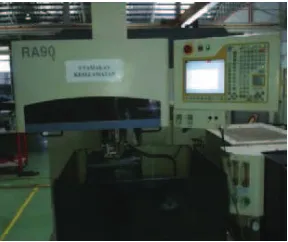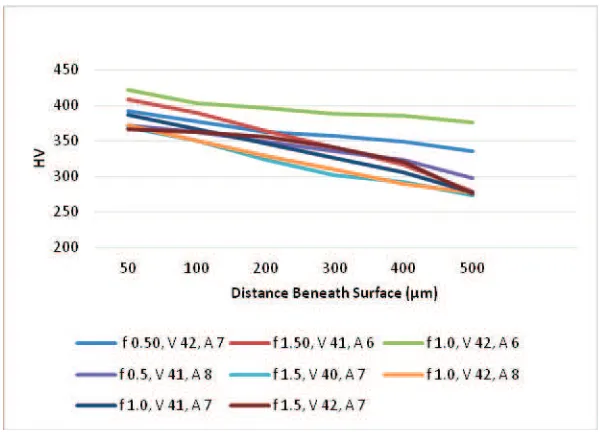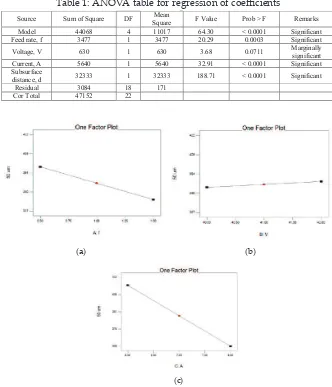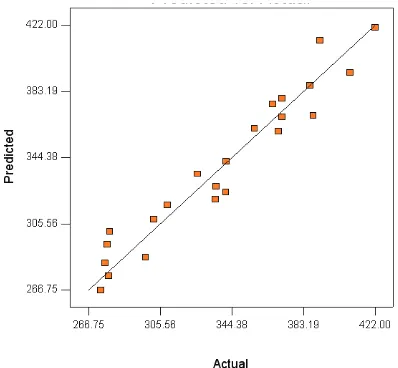THE EFFECT OF WEDM CUTTING PARAMETER ON INCONEL 718 SUBSURFACE MICROHARDNESS
M.S., Kasim1, M.S.M., Zahudi2, C.H.C., Haron3, J.A., Ghani4, R., Izamshah5, M.H., Isa6, J.B., Saedon7, Tauik8 and T., ITO9 1,2,5,6Faculty of Manufacturing Engineering, Universiti Teknikal Malaysia
Melaka, Hang Tuah Jaya, 76100 Durian Tunggal, Melaka, Malaysia.
3,4Faculty of Engineering and Built Environment, Universiti Kebangsaan Malaysia, Bangi, 43600 Selangor, Malaysia.
7Faculty of Mechanical Engineering, Universiti Teknologi Malaysia, Shah Alam, 40450 Selangor, Malaysia.
8Graduate Program in Industrial Engineering, Bina Nusantara University, 11530 Jakarta, Indonesia.
9The University of Tokushima, Institute of Technology and Science Minami-Josanjima 2-1, Tokushima-shi, Tokushima, 770-8506 Japan
Email: *1[email protected], 2[email protected]; 3[email protected], 4[email protected], 5[email protected], 6[email protected],
7[email protected], [email protected], 9[email protected]
ABSTRACT: This paper reports on the efect of wire electrical
discharge machine (WEDM) cuting parameter on the subsurface
hardness of Inconel 718. The response surface methodology (RSM)
using Box-Behnken design was used to conduct the experiment and analyze the relationship between control variables and responses. A total of 8 runs was carried out during the experiment. The Historical Data of Response Surface Methodology (RSM) was used as a tool of design of experiment (DOE). The selected WEDM parameters were
Voltage (40-42V), feed rate (6-8V) and current (0.5-1.5 mm/min). The
subsurface hardness was measured at the distance of 50 µm, 100 µm, 300 µm, 500 µm beneath the cuting surface. Observation of the results shows that the subsurface hardness is higher at the distance of 50µm than 500 um. The hardness was gradually decreased toward bulk hardness of HV0.1 270. Analysis of variance (ANOVA) was used to identify the signiicant efect of the factors on the response. Based on the analysis, feed rate and current were found to be the most signiicant factors in hardness change. Mathematical models were developed for hardness prediction with an average error of 2.7%. The minimum hardness change of HV0.1 30 was obtained by
KEYWORDS: Wire Electrical Discharge Machine, Response Surface Methodology, Historical Data, Inconel 718, Subsurface Microhardness
1.0 INTRODUCTION
WEDM is one of the non-contact cuting process. The process gaining
popular in mold making, aerospace, automotive, industry due to high
precision (±5 µm) and beter surface inish (0.2 µm). The material
removed by mean of a controlled rapid and repetitive electrical spark
discharge between the tool and work piece that caused electrical
erosion of conductive materials. The process creates a small gap of 0.01
– 0.5 µm [1]. The spark temperature of WEDM can reach 12,000°C far than suicient to melt and evaporate of Inconel 718 creating fomation of recast layer [2]. The changes of the microstructure from asrternite to martensite creating undesireable hard but britle white layer [3].
Inconel 718 is a popular material in aerospace engine due to chemical and mechanical resistance. The requirement for aerospace component is very crucial to avoid problem occurrence during operation. The characteristics of surface integrity post machining include normal residual stress, no cracks, no discoloration, no foreign material, no
white layer, no redeposit layer, no recrystallized zone, no recast layer, no porosity. The surface roughness should be less than 0.8 µm in order to obtain this characteristics [4].
The efect of cuting parameter on subsurface hardness in WEDM
is studied less extensively by researchers, although there are some important features that contribute to surface integrity. The parameter
that always reported was peek current, duty factor and pulse-on time. [5] reported that the material removal rate (MRR) increases as the pulse on time and current increases. However, the MRR decreased as the voltage and pulse of increased. This paper presents the inluence of cuting parameter on microhardness of Inconel 718 subsurface.
2.0 METHODOLOGY
18.30% Cr, 18.7% Fe, 5.05% Nb, 3.05% Mo, 1.05% Ti, 0.23% Mn and C balance (% wt.). All tests were done by using Mitsubishi WEDM RA90 Series. The brass wire of 0.25 mm diameter was used in this test due to low cost and high material removal rate for inishing process. Distilled water was used as lubricant and dielectric luid.
Figure 1: Dimension of Inconel 718
Figure 1: WEDM model MITSUBISHI RA
Figure 2: WEDM model MITSUBISHI RA 90
The specimens were cut into a straight line with the following cuting
parameter; Servo voltage (SV) 40-42V, peak current 6-8A, feed rate
0.5 – 1.5 mm/min. The wire speed and pulse of time were maintained at 8 m/min and 1µsec respectively throughout the experiments. After machining, the specimens were cross sectioned cut with precision cuter. The cross section of the sample was ground and polished with 400, 600, 800 and 1200 grit of Silicon Carbide sanding disc. The microhardness machine used in this study was Mitutoyo HM 200. The hardness of mirror inished sample was measured seven times at diferent subsurface depth (50 µm, 300 µm, 500 µm). The hardness reading is commonly luctuates by 50% [6]. To establish minimum
deviation of average value, the measured hardness exceed than 20%
2.5 times of diagonal indenter, d to avoid the efect of work-hardened regions by previous indenter and the new indenter edge [7].
3.0 RESULTS
Figure 3 shows the image of a cross section Inconel 718 after WEDM process. The SEM image shows the minimum thickness range of 3 – 10 µm recast layer with no micro-crack detection. Some literatures consider recast layer also as unetchable white layer [8]. However, 1 µm of thin white layer was detected underneath the recast layer, which was identiiable in both of the parent and recast layer materials.
Figure 2: SEM image of a recast layer and white layer after WEDM
Recast layer 3 -10µm
White layer ~1µm
Figure 3: SEM image of a recast layer and white layer after WEDM
Figure 4 shows the hardness proile at diferent cuting parameters. Generally, the higher hardness value was obtained near the machined
surface. This is caused by the remaining carbon rich recast layer and the quenching process by dielectric. The other factor is a residual stress caused by thermal input so that this region is named as altered
sub-surface material zone [6]. The trend of signiicant parameter is hard to be distinguished. Thus, ANOVA was used to aid in determining the most contributing factor which will be discussed later. It was notiied that the cuting process of WEDM causes increase of speciments microhardness. The hardest proile was identiied close to the machined surface and gradually decreased further from the surface toward bulk nominal hardness of HV 270. Unlike traditional contact cuting process (milling and turning) which normally the machined afected zone (MAZ) was between 200 – 500 µm and some 50 µm [9,10]. MAZ for WEDM was detected beyond 500 µm. Only the combination parameter
of feed rate 1.0 mm/min, Servo voltage 40V, current 7A and feed rate 1.0 mm/min, servo voltage 42V, current 8A can minimize MAZ gap
Analysis of variance for microhardness was performed to identify the inluence of cuting parameter on microhardness. Table 1 is the ANOVA table for microhardness test. Based on the result at 95% conidence
level, the distance of subsurface measurement, current and feed rate
had a signiicant efect on microhardness with p-value less than 5%. The cuting voltage found to be marginally signiicant. Subsurface
distance is the most contributing factor due to highest F-value (188.71) than current (32.91), feed rate (20.29) and voltage (0.07).
Figure 3: Hardness profile at different cutting parameters Figure 4: Hardness proile at diferent cuting parameters
Table 1: ANOVA table for regression of coeicientsTable 1: ANOVA table for regression of coefficients
Source Sum of Square DF Mean
Square F Value Prob > F Remarks Model 44068 4 11017 64.30 < 0.0001 Significant Feed rate, f 3477 1 3477 20.29 0.0003 Significant Voltage, V 630 1 630 3.68 0.0711 Marginally
significant Current, A 5640 1 5640 32.91 < 0.0001 Significant Subsurface
distance, d 32333 1 32333 188.71 < 0.0001 Significant Residual 3084 18 171
Cor Total 47152 22
(a) (b)
(c)
Figure 4: Correlation between variable cutting input against hardness; (a) feed rate (b) Figure 5: Correlation between variable cuting input against hardness;
(a) feed rate (b) servo voltage (c) current
In this work, a mathematical model was developed using a historical data
of Response Surface Methodology (RSM). Based on the experimental data. The linear in the normal operating ranges is inadequately modeled
by the irst-order function. This irst order model can be denoted by the following equation:
(1)
scatered along the straight line indicates beter prediction model. The accuracy of the model was tested by comparing the computed values and actual values where the average error found to be 3%.
gure 5: Prediction vs actual value of subsurface microha
Figure 6: Prediction vs actual value of subsurface microhardness
4.0 CONCLUSION
A series of experiments using historical data of RSM were conducted to investigate the efect of cuting parameter during WEDM of Inconel
718 on the subsurface hardness. The conclusion of the experiment can
be summarized as follows:
1. Hardness of nickel-based alloy surface slowly reduces at beneath surface. It shows in the HAZ area has higher hardness and slightly reduce for a distance of 500µm. Then, the hardness will maintain at bulk hardness which is HV
270. The machining process of WEDM produces heat at the
specimens cuting surface and generate the work hardening.
2. The microhardness prediction model was developed to predict the efect of cuting process by WEDM on subsurface hardness. The average deviation between predicted and
measured microhardness value at various subsurface depth
was approximately 3%.
3. The optimal WEDM cuting parameter as to achieve
mm/s, servo voltage, V = 40.33V, current, A = 7.94A. With this parameter, the minimum subsurface hardness change of HV 64 can be obtained.
ACKNOWLEDGMENTS
This research would not have been possible without technical and inancial support from AMC of Faculty of Manufacturing Engineering,
Universiti Teknikal Malaysia Melaka; AMREG of Faculty of Engineering and Built Environment, Universiti Kebangsaan Malaysia and Government of Malaysia (Project no. PJP/2013/FKP (18A)/S01276 and LRGS/TD/2012/USM-UKM/PT/05).
REFERENCES
[1] G. K. M. Rao, S. Satyanarayana and M. Praveen, “Inluence of
Machining Parameters on Electric Discharge Machining of Maraging
Steels – an Experimental Investigation,” in World Congress on
Engineering, London, 2008, pp. 1536-1541.
[2] H. T. Lee and T. Y. Tai, “Relationship between Edm Parameters and
Surface Crack Formation,” Journal of Materials Processing Technology, vol. 142, pp. 676-683, 2003.
[3] K. Sipos, Lopez, Marta y Trucco, Mauricio, “Surface Martensite White
Layer Produced by Adhesive Sliding Wear-Friction in AISI 1065 Steel,” Rev. LatinAm. Metal. Mater, vol. 28, pp. 46-50, 2008.
[4] F. Klocke, D. Welling, J. Dieckmann, D. Veselovac and R. Perez, “Developments in Wire-Edm for the Manufacturing of Fir Tree Slots
in Turbine Discs Made of Inconel 718,” in 15th Conference of the
European Scientiic Association on Material Forming, ESAFORM
2012 vol. 504-506, ed. Erlangen, 2012, pp. 1177-1182.
[5] H. Singh and R. Garg, “Efects of Process Parameters on Material
Removal Rate in Wedm,” Journal of Achievements in Materials and Manufacturing Engineering, vol. 32, pp. 70 - 74, 2009.
[6] B. Griiths, Manufacturing Surface Technology: Surface Integrity & Functional Performance, London: Penton Press, 2001.
[7] E384-10, “Standard Test Method for Knoop and Vickers Hardness of
Materials,” ed. West Conshohocken: ASTM Internaitonal, p. 42, 2010. [8] D. Sudhakara, B. V. Naik and B. Sreenivasulu, “The Experimental
Analysis of Surface Characteristics of Inconel-718 Using Electrical
[9] K. Zhuang, D. Zhu, X. Zhang and H. Ding, “Notch Wear Prediction Model in Turning of Inconel 718 with Ceramic Tools Considering the Inluence of Work Hardened Layer,” Wear, vol. 313, pp. 63-74, 2014.
[10] B.R.Sridhar, S.Ramachandra and U.Chandrasekar, “Residual Stress in
Nickel Base Super Alloy Udimet 720 for Diferent Surface Conditions,”




